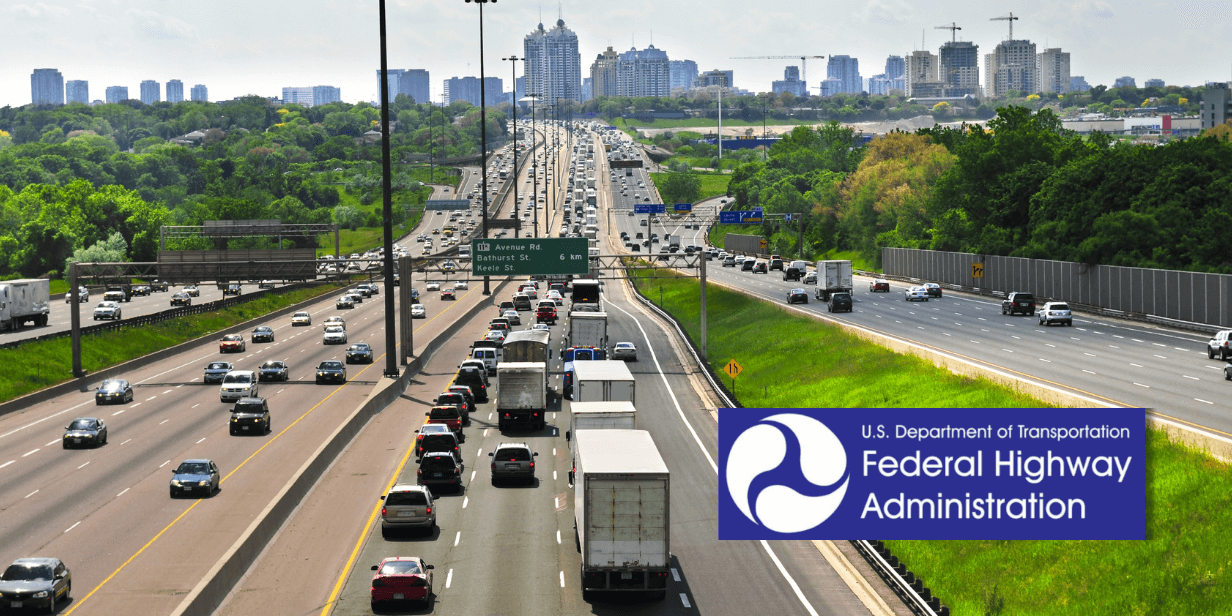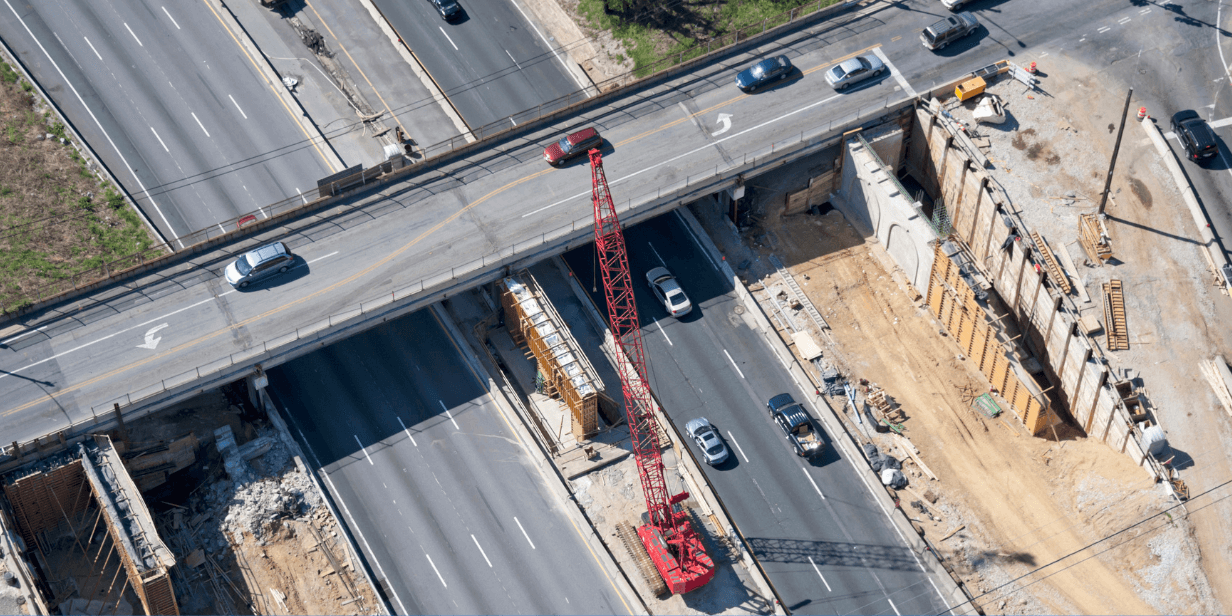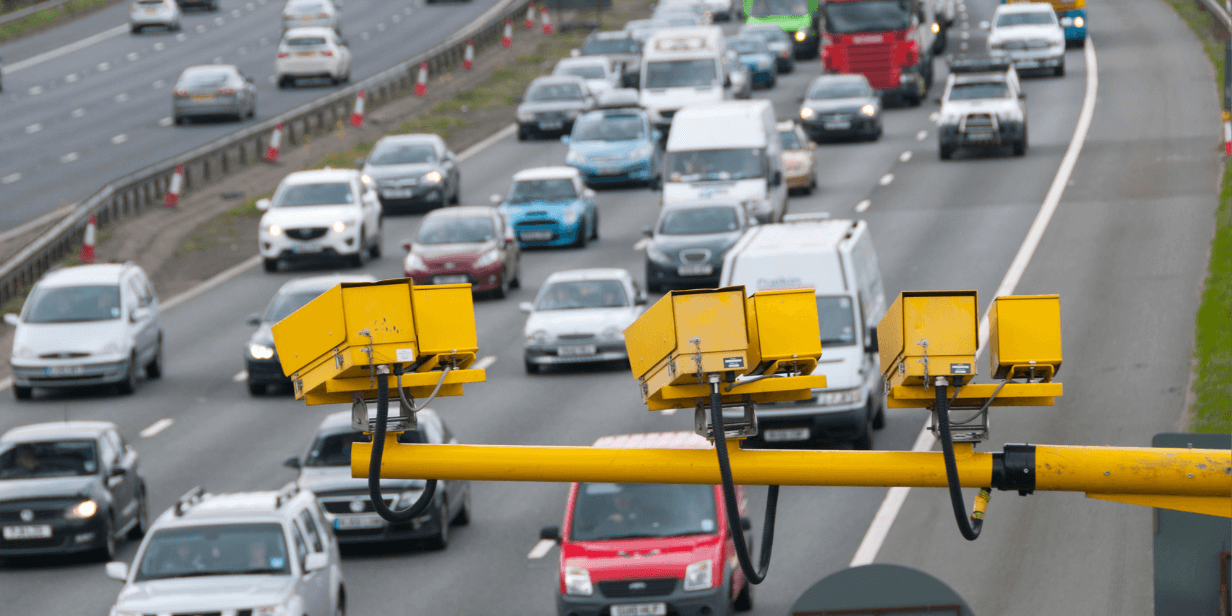Measuring highway traffic volume allows the Federal Highway Administration (FHWA) and other transportation stakeholders to better understand the usage of the nation’s highways, identify areas for improvement, and make evidence-based decisions to enhance mobility, safety, and efficiency in the transportation network.
Today, we learn about the different methods employed by the FHWA to gather this data, how measuring highway traffic volume impacts transportation planning and infrastructure development, and how Automatic License Plate Recognition (ALPR) technology can provide additional insights and enhance the data collection process.

Photo of a busy Highway with the logo of FHWA. Source: Canva
What is the Federal Highway Administration (FHWA)?
The Federal Highway Administration (FHWA) is an agency within the United States Department of Transportation (USDOT) responsible for ensuring the safety and efficiency of the nation’s highway transportation system.
Established in 1966, the FHWA oversees the construction, maintenance, and operation of the federal highway system, which includes thousands of miles of roads and bridges across the country.
The primary mission of the FHWA is to improve mobility and promote economic growth by advancing the quality and safety of the nation’s highways. The agency works in partnership with state and local governments and other stakeholders to develop and implement policies, programs, and projects to enhance the nation’s transportation infrastructure.
Gathering Data Through Traffic Monitoring
While the FHWA primarily focuses on overseeing the nation’s highway system and supporting state and local transportation agencies, traffic monitoring is one of the crucial aspects of its responsibilities.
The agency collects and analyzes traffic data for transportation planning, infrastructure management, policy development, and decision-making processes. This includes gathering information on highway traffic volume, vehicle classification, speed, and other relevant parameters to assess roadway usage and performance.
The FHWA collaborates with state departments of transportation (DOTs), metropolitan planning organizations (MPOs), and other stakeholders to establish standards and guidelines for traffic monitoring practices. It provides technical assistance, guidance, and funding support to enhance traffic monitoring capabilities at the federal, state, and local levels.
The primary mission of the FHWA is to improve mobility and promote economic growth by advancing the quality and safety of the nation’s highways. The agency works in partnership with state and local governments and other stakeholders to develop and implement policies, programs, and projects to enhance the nation’s transportation infrastructure.
Highway Traffic Volume: Gaining Insight into the Nation’s Highways
Highway Traffic Volume, often referred to simply as traffic volume, is a critical metric in transportation planning and management. It quantifies the number of vehicles using a particular stretch of highway or roadway over a specified period.
The data is collected through various methods, including automatic traffic counters, manual traffic counts, and video-based monitoring systems. These data collection techniques provide transportation agencies with insights into traffic patterns, trends, and behavior, which are important for making informed decisions to improve mobility, safety, and efficiency on the nation’s highways.

Aerial view of a highway with construction happening on the sides. Source: Canva
Accurately measuring and analyzing highway traffic volume also enables transportation agencies to optimize traffic flow, mitigate environmental impacts, and assess the economic benefits of transportation investments.
Methods Used in Collecting Highway Traffic Volume Data
Below are different methods used by the FWHA and its partner agencies to collect highway traffic volume data. Each method offers unique advantages and capabilities, allowing transportation agencies to collect accurate and comprehensive data on traffic flow, vehicle movements, and travel patterns:
1. Automatic Traffic Counters (ATCs)
Automatic Traffic Counters are electronic devices installed at specific locations along highways or roadways to continuously record the number of vehicles passing through. ATCs utilize various sensors, such as inductive loops, microwave radar, infrared detectors, or laser sensors, to detect vehicle presence and count traffic.
These devices can provide detailed data on traffic volume, including counts by vehicle type, direction of travel, and time of day. ATCs are typically installed permanently and can operate continuously, providing real-time traffic volume information.
2. Manual Traffic Counts
Manual traffic counts involve trained personnel physically observing and tallying the number of vehicles passing through a particular location over a specified period. Manual counts may be conducted using handheld tally counters or electronic counting boards. This method is time-consuming and labor-intensive but it can provide accurate data for validating automatic count systems and capturing additional information such as vehicle classification and turning movements.
3. Weigh-in-Motion (WIM) Systems
WIM systems are primarily used for measuring the weight of vehicles as they pass over sensors embedded in the roadway. While primarily used for weight enforcement and monitoring commercial truck traffic, WIM systems can also provide data on traffic volume by counting and classifying vehicles based on weight categories. WIM systems can provide valuable insights into the composition of traffic and help assess the impact of heavy vehicles on roadway infrastructure.

Red truck with a white trailer on the highway. Source: Canva
4. Video-based Traffic Monitoring
Video-based traffic monitoring systems use cameras installed at strategic locations along highways to capture footage of traffic flow. Advanced video analytics software analyzes the video footage to automatically count and classify vehicles based on size, speed, and other parameters. Video-based monitoring offers the advantage of collecting comprehensive data without the need for physical sensors or infrastructure modifications. Video data can also be used for other purposes such as incident detection, traffic management, and enforcement.
Plate Recognizer Capability:
With Plate Recognizer, any camera can be used for traffic monitoring, even cameras that don’t have license plate recognition capabilities. Video files can be analyzed programmatically to count vehicles, analyze vehicle types, and gather other relevant data.
Measuring Highway Traffic Volume Using Automatic License Plate Recognition (ALPR)

Motorway cameras monitoring traffic. Source: Canva
Although Automatic License Plate Readers (ALPR) are not primarily used to directly measure highway traffic volume, they are used in conjunction with other sensor technologies for FHWA‘s traffic monitoring efforts. ALPR systems are integrated with existing infrastructure so transportation agencies can expand their data collection capabilities to gather comprehensive traffic data for various applications.
For example, ALPR systems are sometimes combined with inductive loops and axle sensors to collect a wide range of data at the same monitoring site, including individual vehicle records, vehicle classification based on axles, vehicle length, speed, axle spacing, axle weights, gap, headway, and lane occupancy.
While ALPR systems are primarily designed for capturing license plate numbers of passing vehicles, they can potentially be utilized as a tool for measuring highway traffic volume. Here’s how ALPR can be used for this purpose:
Vehicle Counting
ALPR systems can be strategically placed at key locations along highways to capture images of passing vehicles and record their license plate numbers. By analyzing the timestamped data collected from each vehicle sighting, transportation agencies can calculate the number of vehicles passing through the monitored area within a given timeframe. This data can provide insights into traffic volume trends and patterns.
Plate Recognizer Capability:
Vehicle type counting is now possible. Plate Recognizer doesn’t just provide ALPR systems that can count the number of vehicles passing. Our program also has the capability of counting the vehicle types which can provide better insight into weight impact on roads and other infrastructures. For example, we can count the number of Big Rig Trucks passing through each day during different seasons to ensure that the ground load can handle the weight.
Time-Stamped Data Collection
ALPR systems automatically timestamp each vehicle sighting, allowing transportation agencies to analyze traffic volume variations throughout the day, week, month, or year. By aggregating the timestamped data, agencies can identify peak traffic hours, daily traffic patterns, and seasonal variations in traffic volume.

Aerial view of highway infrastructure. Source: Canva
ALPR systems can be installed to monitor specific lanes or sections of a highway, enabling transportation agencies to measure traffic volume on a lane-by-lane basis. This granular data allows agencies to identify congestion hotspots, lane utilization rates, and traffic flow dynamics within different lanes.
Integration with Other Data Sources
ALPR data can be integrated with data from other traffic monitoring technologies, such as automatic traffic counters and video-based monitoring systems, to enhance the accuracy and reliability of traffic volume measurements. By combining data from multiple sources, transportation agencies can validate traffic volume estimates and gain a more comprehensive understanding of highway traffic dynamics.
ALPR’s ability to capture timestamped vehicle sightings makes it a potentially valuable tool for measuring highway traffic volume when integrated into comprehensive traffic monitoring strategies.
Summary: Improving Highways Through Traffic Volume Analysis
Measuring highway traffic volume is essential for the Federal Highway Administration (FHWA) and other transportation stakeholders to effectively manage and improve the nation’s transportation infrastructure.

Different types of vehicles traveling on a highway. Source: Canva
Through various data collection methods such as automatic traffic counters, manual traffic counts, and advanced technologies like Automatic License Plate Recognition (ALPR), agencies can gather comprehensive insights into traffic patterns, trends, and behavior.
These insights play a major role in informing evidence-based decisions for enhancing mobility, safety, and efficiency on the nation’s highways.
By continually refining data collection techniques and leveraging innovative technologies like ALPR, transportation agencies can stay at the forefront of transportation planning and infrastructure development, ensuring a smoother and safer journey for all road users.
Test Drive ALPR to Measure Highway Traffic Volume for Free
Discover the potential of Automatic License Plate Recognition (ALPR) technology to revolutionize your highway traffic volume monitoring efforts.
With our ALPR technology, you can:
Seamlessly capture and analyze vehicle data in real time, including traffic volume, vehicle classification, and travel patterns.
Leverage advanced analytics tools to identify traffic trends, optimize roadway utilization, and improve overall transportation efficiency.
Enhance safety and security by monitoring lane-specific traffic flow, identifying congestion hotspots, and detecting suspicious or unauthorized vehicles.
Identify various vehicle types passing through a specific lane.
And more…
If you’re interested in trying our ALPR technology to measure highway traffic volume, you can test drive the ALPR for free by signing up for an account today. For more questions, send us a message anytime. We’re ready to answer them.





